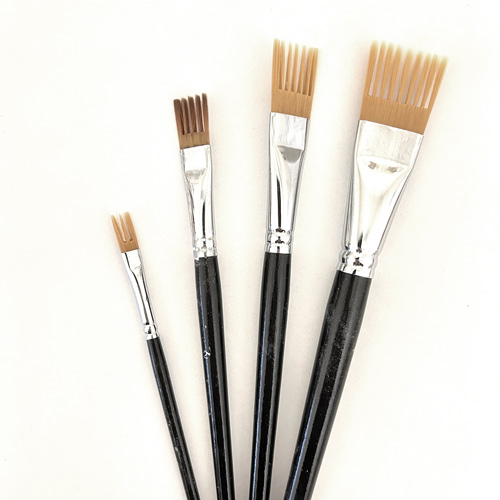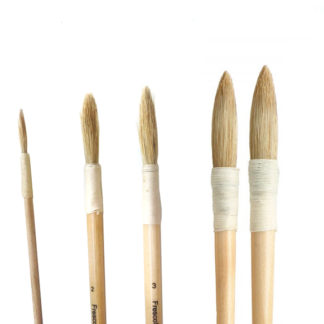In fresco painting Milk of Lime or Limewater is used for grinding pigments in preparation of the paints, and for wetting the plaster prior to application of the consecutive plaster layer.
Milk of Lime or Limewater is the common name for a saturated aqueous solution of calcium hydroxide. Calcium hydroxide, Ca(OH)2, is sparsely soluble at room temperature in water. “Pure” (i.e. less than or fully saturated) limewater is clear and colorless, with a slight earthy smell and an astringent/bitter taste. It is basic in nature with a pH of 12.4.
Limewater may be prepared by mixing calcium hydroxide (Ca(OH)2) with water and removing excess undissolved solute (e.g. by filtration). When excess calcium hydroxide is added (or when environmental conditions are altered, e.g. when its temperature is raised sufficiently), a milky solution results due to the homogeneous suspension of excess calcium hydroxide. This liquid has been known traditionally as milk of lime. Wikipedia
Milk of lime is a highly alkaline (basic) material with a large number of industrial uses, as well as food processing and medicine:
- in water and wastewater treatment processes for pH adjustment, contaminant removal, disinfection and water softening.
- to help separate non-ferrous metals from their parent rocks, either in flotation processes or as part of metathesis (double displacement) reactions.
- as a base (alkali) for pH adjustment, as a desiccant or in metathesis reactions in the manufacturing of chemicals.
- to modify and stabilize soils, particularly clay soils, in civil engineering and construction applications.
- M for biosolid treatment and soil improvement in agriculture.
- to help purify raw sugar juice in sugar refining.
- In the preparation of maize for corn tortillas and other culinary purposes using a process known as nixtamalization
- as food supplement and in pharmaceuticals
Milk of lime is also known by a number of other generic terms, such as lime slurry, whitewash and limewater. Milk of lime is made by mixing calcium oxide (CaO) with water in an exothermic reaction known as lime slaking: CaO + H2O → Ca(OH)2
This reaction initially produces a hydrated lime or slaked lime ( Slaked Lime Putty). Continuing to add water allows for the liquid solution known as milk of lime to be produced. Essentially Milk of Lime is a suspension of Calcium Hydroxide [Ca(OH)2] in water. This suspension of Ca(OH)2 usually contains between 15% and 35% Ca(OH)2 by weight of solids.
Milk of lime storage is important. Just like Slaked Lime Putty it should be stored in sealed containers to prevent it from calcifying – CO2 from reacting with Ca(OH)2 in it.
[pics]
Ca(OH02 is sparsely soluble and Milk of Lime appears as white “milk like” liquid only if it is constantly vibrated (when used industrially) and/or when it contains an excess of Ca(OH)2 – about 30-40% (as in our Milk of Lime Concentrate). In its “normal” state it will “separate” almost immediately with excess Ca(OH)2 settling down with clear limewater solution on the top. It is this, clear, Limewater solution that is used for preparing paint for fresco.
Milk of Lime prepared directly from CaO and/or collected from the aged slaked lime putty will have the most saturated Limewater solution, which is ideal for the preparation of the paint for fresco, it will aid paint adhesion the most.
In fresco painting, pigments are ground into paste and diluted with Clear Limewater from Milk of Lime on the day of painting. If limewater is milky – wait for it to settle down. Use only the clear portion or your colors will whitewash. Fresco Paints prepared on Milk of Lime begin to calcify as soon as mixed. For best result and clarity of color, paints should be used right away (on the same day).
Fresco School advises to prepare a new batch of colors (paints) every 4-5 hours of painting. Pigments can be ground with distilled water into paste/dispersion and stored indefinitely, then mixed into paints with Limewater from Milk of Lime as needed. A detailed tutorial on Fresco Pigments & Paints is part of FS Membership.
Limewater for pigments can be made from the Lime Putty as needed, however it is advised to have it “saturate” for some time. For your convenience, FrescoShop offers a fully saturated Lime Water and/or Milk of Lime Concentrate.
Milk of Lime is also used for wetting the plaster prior to applying the consecutive layer. For example wetting arriccio layer prior to application of the intonaco. For fresco plaster Milk of Lime is used directly as a solution of 10-15% Slaked Lime Putty and Water by volume.







